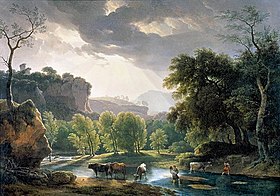Campagna Romana
The Campagna Romana , also Campagna for short (not to be confused with Campania , Italian Regione di Campania ), is the hilly area of Rome between the Tyrrhenian Sea and the Apennines . In the common sense, Campagna refers to the part of the Latium region (Italian: Lazio ) between Rome or the Albanians and the Sabine Mountains (altitude up to 1300 meters) crossed by the Roman Via Appia and characterized by ancient grave monuments and ruins of Roman aqueducts . The main rivers are the Tiber and the Aniene . Although the boundaries of the Campagna cannot be precisely determined, one can assume an area of around 2,100 square kilometers.
history

In ancient times, intensive agriculture was practiced here, not least to supply the capital; numerous wealthy Roman citizens built manors here, mostly in the form of luxurious villas . In the Middle Ages, however, irrigation problems, extensive deforestation in earlier centuries and, last but not least, the constant threat from malaria led to a depopulation of the Roman area. It was not until the 19th and 20th centuries that there was a renewed upswing. a. by draining the Pontine swamps .
Geology and topography
The main geological features of the landscape, which has been famous for centuries for its aesthetic and tourist attractions, are the lava layers and the volcanic tuffs of the neighboring Alban Mountains (height up to 948 meters; with Lake Albano , which was used as a water reservoir since Roman times. Alba Longa is considered the oldest Latin city) or the Monti Cimini . Today's Lago di Bracciano (Latin: Lacus Sabatinus , about 60 km from Rome) is a former volcanic crater . The volcanic region around the lakes was last active around 225,000 years ago. Today the Lago di Bracciano with the medieval town of Anguillara Sabazia is a popular destination for vacationers and weekenders. Faleria are also known , in the nearby Fort Paterno Emperor Otto III. have been poisoned, and the artist village of Calcata, built on a tuff rock .
Places and landscapes of the same name
Campagna is also the name of an Italian municipality in the province of Salerno . Campagna Lupia is a town in the province of Veneto . There is also a Campagna Adorna in Switzerland (a landscape). Other bucolic landscapes are also often referred to - more or less justified - with reference to the Campagna, provided that corresponding similarities are identified. Since the word simply means landscape in Italian (it can also mean a campaign !), It is also used there for campagna toscana , campagna pisana etc.
Effect and reception

The Roman Campagna (out of date Germanized, sometimes also Kampagna ) has attracted and inspired numerous artists and educational travelers . Very well known is Johann Heinrich Wilhelm Tischbein paintings by Johann Wolfgang Goethe , the Poet in this landscape shows.
On October 28, 1786, Goethe traveled on the Via Flaminia towards Rome. His impressions:
- “ The road that goes from the heights to Città Castellana , from this very stone, driven very smoothly, the city built on volcanic tuff, in which I thought I discovered ash, pumice and pieces of lava. The view from the castle is very beautiful; the mountain Soracte stands there in a picturesque way, probably a limestone mountain belonging to the Apennines . The vulcanizing stretches are much lower than the Apennines, and only the rushing water has formed mountains and rocks out of them, as wonderfully picturesque objects, overhanging cliffs and other scenic contingencies are formed. "
Another famous German traveler to Italy, namely Ferdinand Gregorovius , raves in the middle of the 19th century:
- “ I have crossed most of Italy, I have wandered through the famous corridors of Agrigento and Syracuse , but despite all the blaze of color in that southern zone, I must confess that the Campagna of Rome and Latium make the most powerful impression on me. (...) It lies there like a sublime theater of history, a great stage in the world. Not a word by the poet, not a brushstroke by the painter, as many pictures of it have been painted, can even hint at the glorified heroic beauty of Lazio to those who did not see and feel it themselves. "
literature
- Sternfeld, Joel: Campagna Romana. The Countryside of Ancient Rome. New York: Alfred A. Knopf, 1992. (Photo book)
Web links
- Rainer Maria Rilke , Roman Campagna (poem, 1908)
- Goethe: Italian journey in the Gutenberg-DE project
- Gregorovius : Years of Wandering in Italy: From the Campagna of Rome, 1856 and 1858 in: Project Gutenberg-DE
- EMA Bonn-ROMA (extensive link list)
- Comprehensive literature list
- The Caffarella Valley
- The Campagna in ancient views

